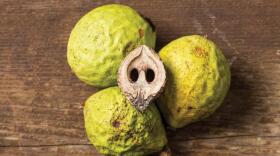Persimmons are a sweet fall treat often used in breads, puddings, and pies. They're also a favorite for wildlife (so you may have to race the raccoons to harvest them).
This homegrown fruit comes from a common midwestern tree that is very distinct. The wood is very hard and dense which is ideal for golf club heads and billiard cues. The fruit is what it's known for and is highly favored for fall recipes.
The orange fruit usually ripens around the first frost. Be sure the fruit is completely ripe before eating one, because nothing can make you pucker more than a green persimmon. Scout for orange ones that are soft and mushy. The easiest method to harvest persimmons is to gather fruits that have fallen to the ground. The aroma is wonderful (and you will also be competing with opossums and birds for your harvest!)
After you've collected your fruit, strain the persimmons through a colander to remove the large seeds. You'll end up with pulp, which is smooth and bright orange. Now you're ready to make the pulp into bread, pudding, pie, butter, or jelly. Most people agree that persimmons taste best when they get so soft the skin starts to sag and the pulp is mushy.
Persimmons are a very important wildlife food, and it is eaten by many birds, as well as squirrels, wild turkey, and deer.
Learn more about Missouri’s persimmons at MissouriConservation.org.



